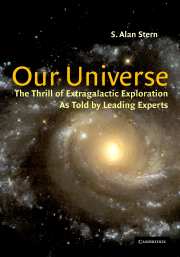Book contents
- Frontmatter
- Contents
- Preface
- The frontier Universe: At the edge of the night
- Part I Revealing a Universe
- Part II Denizens of the deep
- 5 The search for very massive black holes
- 6 Gamma-ray bursts—the most spectacular fireworks
- 7 Clusters of galaxies and the fate of the Universe (Or how to be a cosmologist without really trying)
- 8 Dark matter and the discovery of galactic halos
- 9 Hunting the elusive invisible galaxy
- Plate section
8 - Dark matter and the discovery of galactic halos
Published online by Cambridge University Press: 03 September 2009
- Frontmatter
- Contents
- Preface
- The frontier Universe: At the edge of the night
- Part I Revealing a Universe
- Part II Denizens of the deep
- 5 The search for very massive black holes
- 6 Gamma-ray bursts—the most spectacular fireworks
- 7 Clusters of galaxies and the fate of the Universe (Or how to be a cosmologist without really trying)
- 8 Dark matter and the discovery of galactic halos
- 9 Hunting the elusive invisible galaxy
- Plate section
Summary
Jeremiah Ostriker received his doctorate in astrophysical sciences from the University of Chicago, under the tutelage of the legendary astrophysicist and Nobel laureate, S. Chandrasekhar. After receiving his doctorate, Jerry held a postdoctoral position at Cambridge University. He then went to Princeton University, where he became the Chair of the Department of Astrophysical Sciences and the Director of Princeton University Observatory. Since 1995 he has served as the Provost of Princeton University, while maintaining his position as a professor in the Department of Astrophysical Sciences. Jerry Ostriker's contributions to astrophysics have earned him the recognition of his colleagues in awards as diverse as the Helen B. Warner Prize and the Henry Norris Russell Prize of the American Astronomical Society, the Vainu Bappu Memorial Award of the Indian National Science Academy, and the Karl Schwarzschild Medal of the Astronomische Gesellschaft of Germany. Jerry's research spans much of the field of theoretical astrophysics, with his current interests focusing on cosmology. For this book, he chose to write about one of astronomy's longest-standing mysteries: the dark matter that pervades galaxies.
By now most of even the lay newspaper-reading public has heard of “dark matter.” Where is it? How much of the stuff exists? What is it? And, incidentally, how sure are we of its presence, or could the whole scientific story for its existence collapse?
- Type
- Chapter
- Information
- Our UniverseThe Thrill of Extragalactic Exploration, pp. 127 - 134Publisher: Cambridge University PressPrint publication year: 2001

